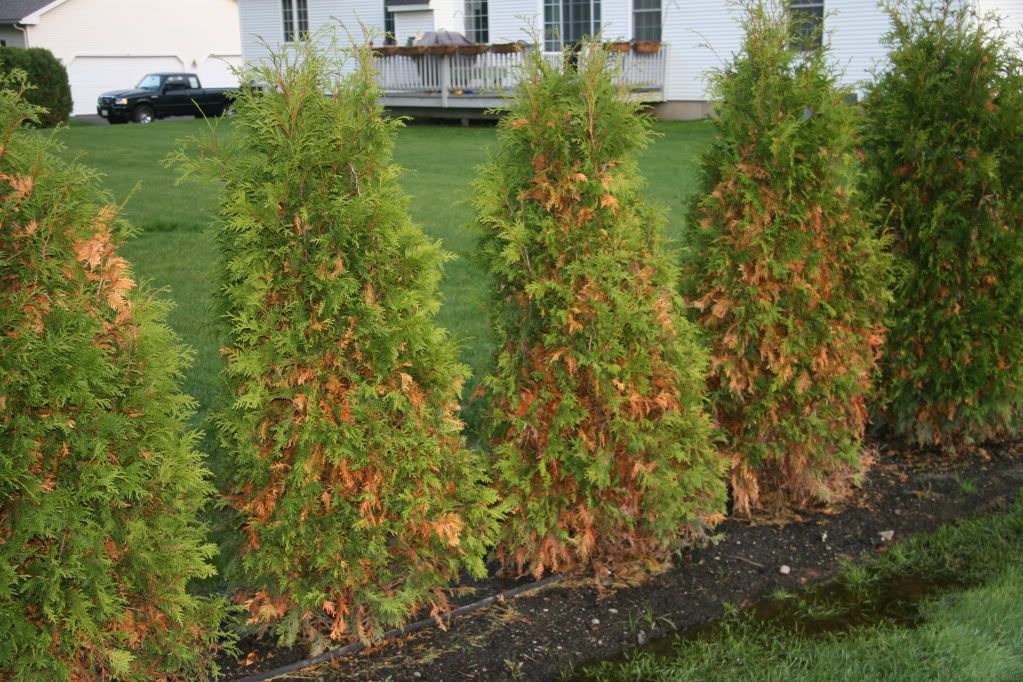You are using an out of date browser. It may not display this or other websites correctly.
You should upgrade or use an alternative browser.
You should upgrade or use an alternative browser.
Are my arborvites dead? 6 look like this
- Thread starter Stephanielee
- Start date

Help Support Arborist Forum:
This site may earn a commission from merchant affiliate
links, including eBay, Amazon, and others.
Stephanielee
ArboristSite Lurker
Are your Arbs being over watered?
Stephanielee
ArboristSite Lurker
Actually, we got very little rain in the month of August and Sept here in Chicago, so I watered the trees one time per week for about 20 minutes a piece (slowly). These trees were put in in 2011 and seem to be looking worse each year. The company came out last summer and claimed they were fine. We spend $1000 on 7 trees. Frustrating. They are not going to admit they are 'toast'.
The first place to investigate is the root collar. Look to see how deeply they were planted & if they have been untied from the burlap.
Stephanielee
ArboristSite Lurker
I hope the guys that installed them (a professional landscaping company) would have done that! I will do some digging (literally) to see.....The first place to investigate is the root collar. Look to see how deeply they were planted & if they have been untied from the burlap.
Stephanielee
ArboristSite Lurker
I should also mention that right behind our property is a federal wetland. The landscaping company assured me when they were planted in 2011 that they were all the same type of Arborvite and fine for moist soil. So you can see in the far left that that tree looks nothing like the others. Looks totally a different type, yet landscaper owner denies it. all were planted the same exact day.The first place to investigate is the root collar. Look to see how deeply they were planted & if they have been untied from the burlap.

If properly planted the most common abiotic disorder I find on Arbs is improper water management.

Pic of stressed Arbs due to low oxygen levels, second year plants. Customers don't consider soil types, drainage, water tables & sun light requirements for a healthy plant.

Pic of stressed Arbs due to low oxygen levels, second year plants. Customers don't consider soil types, drainage, water tables & sun light requirements for a healthy plant.
Stephanielee
ArboristSite Lurker
So since we have a federal wetland right behind our property, the soil probably has too much water. But one tree is fine (the one that seems to be a different type of Arborvite) and the rest look toast. Is this something a landscaping company should be responsible for? They recommended this type and for 4 years look like crap.
If properly planted the most common abiotic disorder I find on Arbs is improper water management.
Pic of stressed Arbs due to low oxygen levels, second year plants. Customers don't consider soil types, drainage, water tables & sun light requirements for a healthy plant.
Look for gelatinous fungal masses in the spring. Might be cedar apple rust. It hits cedars in the spring and they give it back to the apples in the summer. Apples return the favor in the fall. Check any nearby apples trees for damage to the leaves, yellow spots and loss of leaves.
Look for gelatinous fungal masses in the spring. Might be cedar apple rust. It hits cedars in the spring and they give it back to the apples in the summer. Apples return the favor in the fall. Check any nearby apples trees for damage to the leaves, yellow spots and loss of leaves.
You have confused Thuja with juniper.
Similar threads
- Replies
- 66
- Views
- 3K
- Replies
- 2
- Views
- 484
- Replies
- 20
- Views
- 846
- Replies
- 10
- Views
- 2K





